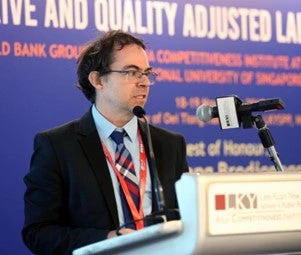 Elevated night view of Makati, Metro Manila's business district. © r.nagy/Shutterstock
Elevated night view of Makati, Metro Manila's business district. © r.nagy/Shutterstock
East Asia’s cities, many of which have hot and humid baseline climates, are in danger of becoming unlivable because of extreme heat. In 2023, climate change has contributed to record-high temperatures across East Asia. The “urban heat island” (UHI) effect raises city temperatures even further. As with climate change, the causes of this UHI effect are man-made, such as cities’ relative lack of vegetation and increased impervious surfaces compared with surrounding rural areas.

How Strong is the UHI Effect?
Based on an analysis of satellite data for 100 East Asian cities, land surface temperatures (LSTs) from 2016 to 2020 were, on average, 2.0°C warmer than in rural areas within 10 kilometers.
This effect varies considerably across cities and within them. Cities in Indonesia, Malaysia, and the Philippines suffer from the strongest UHI effects with average LSTs up to 6.6°C warmer than nearby rural areas. Within cities, the air temperature in the hottest neighborhoods may be several degrees Celsius higher than in the coolest neighborhoods. In many cities, both in East Asia and globally, the UHI effect also tends to be strongest in the poorest neighborhoods. While initially it may seem counterintuitive, for cities generally, the UHI effect is typically stronger at night than during the day. This is because the heat stored in the built environment is gradually released after sunset.
The UHI effect is a particular concern for tropical East Asian cities, where humidity adds to the risk of overheating. These cities already have hot and humid climates and are becoming even hotter and more humid over time because of climate change. In Phnom Penh, Cambodia, the UHI effect contributes to 23-25 heat wave days annually, a figure projected to potentially more than double by 2050 for certain districts.
Implications for health, competitiveness, and livability
To help understand the implications of extreme heat on the health of East Asia’s urban residents and both the competitiveness and livability of its cities, the report surveys the rapidly expanding scientific literature on the impacts of heat stress. Overall, the results are sobering. Already more than 100,000 people in East Asia die each year because of extreme heat. And projections indicate that climate change will further increase heat-related mortality during this century.
Meanwhile, for the world’s largest cities, literature indicates that productivity losses from the combination of the UHI effect and global warming will decrease real gross domestic product (GDP) by 1.4–1.7 percent for the median city by 2050. For the worst-affected city, the loss could reach almost 11 percent by the end of the century. New evidence presented in the report also shows that large Southeast Asian metropolitan cities and other East Asian cities with warmer climates suffer significant losses in economic activity during extreme heat events.
Finally, extreme urban heat makes cities less livable both directly through the unpleasantness of extreme heat—especially when combined with high humidity—and indirectly through other negative impacts, such as potential increases in crime, violence, and motor vehicle accidents.
Addressing Urban Heat: A Blueprint for City Leaders
While the impacts of urban heat are alarming, they can be mitigated with the right local policies. City leaders in East Asia have the tools to help alleviate the UHI effect and better prepare their residents for heatwaves.
The report introduces a “Places, People, Institutions” framework for tackling extreme urban heat. Firstly, making urban places – such as streets, plazas, parks, workplaces, marketplaces, and homes – cooler will reduce heat stress, contributing to a competitive economy and healthy population. Secondly, heat waves endanger specific groups of vulnerable people – including the elderly, children, exposed workers, and people with health vulnerabilities. Providing people with information, health care resources, and respite from extreme heat is crucial to save lives during heatwaves. Finally, extreme heat is a challenge that requires coordinated action across city government institutions working in tandem with local stakeholders such as employers and neighborhood associations.
The “Places, People, Institutions” framework outlines six priority strategies that can help local leaders deliver on a heat resilience agenda:
- promote urban greening through strategic planning;
- cool city spaces through wind, shade, and urban design;
- engage building owners in tackling indoor heat;
- save lives through heat wave early warnings;
- protect heat-exposed workers; and
- mainstream heat risk reduction throughout city institutions and strategies
By tailoring these approaches to local circumstances, East Asia’s leaders can maintain and improve urban livability, ensuring Asian cities thrive as healthy, competitive, and inclusive places.
The report, Unlivable: What the Urban Heat Island Effect Means for East Asia’s Cities, was funded by the Global Facility for Disaster Reduction and Recovery.






Join the Conversation